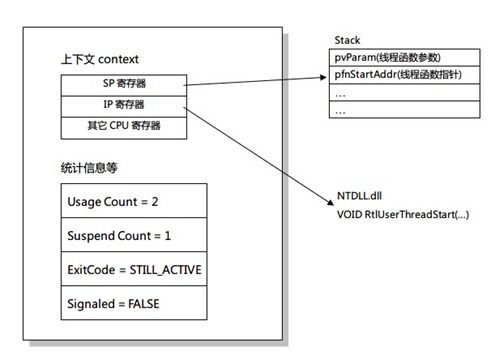win 线程生亡
来源:互联网 发布:qq飞车夜魔数据 编辑:程序博客网 时间:2024/04/30 13:50
特别声明:本文转自 t427 自其然
Windows线程生灭 (二)
上节中介绍了几种Windows平台创建及删除线程的api及它们的差别,这节具体介绍以下信息:
1.线程内核对象(操作系统接口CreateThread内部实现)
2.线程数据块_tiddata(C/C++运行时库的实现 _beginthreadex与_beginthread)
3.线程结束_endthreadex
下面分别介绍
一、线程内核对象

线程创建时,会先创建一个线程内核对象(分配在进程的地址空间上),如上图,存储上下文context(一个数据结构)及一些统计信息,具体包括:
1.寄存器SP:指向栈中线程函数指针的地址
2.寄存器IP:指向装载的NTDLL.dll里RtlUserThreadStart函数地址
3.Usage Count:引用计数,初始化为2
4.Suspend Count:挂起数,初始化为1。
5.ExitCode:退出代码,线程在运行时为STILL_ACTIVE(且初始化为该值)
6.Signaled:初始化为未触发状态
RtlUserThreadStart(...)
函数原型如下:

RtlUserThreadStart函数是线程真正起始执行的地方,因为新线程的指令指针是指向这个函数 。RtlUserThreadStart函数原型使你认为它收到二个参数,但那不是真的,这只是意味着它被调用自另一个函数。新的线程只不过在这里生效和开始执行。
RtlUserThreadStart函数之所以认为被调用自另一个函数,是因为它获得了二个参数。但是获得这些参数的途径是由于操作系统把这些值直接写入了线程的堆栈(通常参数被传递到函数的方法)。
注意,一些CPU架构用CPU寄存器来传递参数,而不是堆栈。对于这些架构,系统在同意线程执行RtlUserThreadStart函数之前会对相应的寄存器进行正确的初始化。
(在32位Windows中用的是BaseThreadStart函数而不是64位Windows中的RtlUserThreadStart函数,BaseThreadStart函数来出自Kernel32.dll组件,而RtlUserThreadStart函数函数来出自于NTDLL.dll组件)
RtlUserThreadStart函数是线程真正开始执行的地方,在函数中
(1)设置了一个围绕线程函数的结构化异常处理SEH帧
(2)线程函数返回时,调用ExitThread,并将线程函数返回值作为参数传递进去。线程内核对象的使用计数递减,而后线程停止执行。
(3)执行期间若发生未被处理的异常,则调用异常处理块中的ExitProgress()关闭进程
当一个程序运行时,会生成一个主线程,之后RtlUserThreadStart开始执行,调用C/C++运行库的代码,后者初始化继而访问你的程序入口函数(_tmain,_tWinMain等);入口函数返回时,C/C++运行时启动代码会调用ExitProcess来结束进程。
因此使用CreateThread生成线程应有二步
(1)生成线程内核对象并初始化
(2)由内核对象指向的RtlUserThreadStart运行线程函数
二、线程数据块_tiddata
线程数据块是_beginthreadex函数维护的一个数据结构,存储了线程相关的一些信息。我们先来看_beginthreadex的源码(VS2008的存储在C:\Program Files\Microsoft Visual Studio 9.0\VC\crt\src\threadex.c中):
_MCRTIMP uintptr_t __cdecl _beginthreadex ( void *security, unsigned stacksize, unsigned (__CLR_OR_STD_CALL * initialcode) (void *), void * argument, unsigned createflag, unsigned *thrdaddr ){ _ptiddata ptd; /* pointer to per-thread data */ uintptr_t thdl; /* thread handle */ unsigned long err = 0L; /* Return from GetLastError() */ unsigned dummyid; /* dummy returned thread ID */ /* validation section */ _VALIDATE_RETURN(initialcode != NULL, EINVAL, 0); /* Initialize FlsGetValue function pointer */ __set_flsgetvalue(); /* * Allocate and initialize a per-thread data structure for the to- * be-created thread. */ if ( (ptd = (_ptiddata)_calloc_crt(1, sizeof(struct _tiddata))) == NULL ) goto error_return; /* * Initialize the per-thread data */ _initptd(ptd, _getptd()->ptlocinfo); ptd->_initaddr = (void *) initialcode; ptd->_initarg = argument; ptd->_thandle = (uintptr_t)(-1);#if defined (_M_CEE) || defined (MRTDLL) if(!_getdomain(&(ptd->__initDomain))) { goto error_return; }#endif /* defined (_M_CEE) || defined (MRTDLL) */ /* * Make sure non-NULL thrdaddr is passed to CreateThread */ if ( thrdaddr == NULL ) thrdaddr = &dummyid; /* * Create the new thread using the parameters supplied by the caller. */ if ( (thdl = (uintptr_t) CreateThread( (LPSECURITY_ATTRIBUTES)security, stacksize, _threadstartex, (LPVOID)ptd, createflag, (LPDWORD)thrdaddr)) == (uintptr_t)0 ) { err = GetLastError(); goto error_return; } /* * Good return */ return(thdl); /* * Error return */error_return: /* * Either ptd is NULL, or it points to the no-longer-necessary block * calloc-ed for the _tiddata struct which should now be freed up. */ _free_crt(ptd); /* * Map the error, if necessary. * * Note: this routine returns 0 for failure, just like the Win32 * API CreateThread, but _beginthread() returns -1 for failure. */ if ( err != 0L ) _dosmaperr(err); return( (uintptr_t)0 );}
其中被标红加粗的二部分是重点,即首先初始化了一个线程数据块(_ptiddata ptd),将线程函数地址及参数设置到线程数据块内,该块是分配在堆上的。之后调用CreateThread函数创建线程,要注意传入该函数的参数,即要运行的函数_threadstartex(注意不是线程函数), 其参数是线程数据块(LPVOID)ptd
_threadstartex的功能是
1.将新建线程与内存数据块关联(__fls_setvalue,该函数是操作系统函数,即所谓的线程局部存储(Thread Local Storage, TLS))
2.调用_callthreadstartex来执行及终结真正的线程函数
static unsigned long WINAPI _threadstartex ( void * ptd ){ _ptiddata _ptd; /* pointer to per-thread data */ /* Initialize FlsGetValue function pointer */ __set_flsgetvalue(); /* * Check if ptd is initialised during THREAD_ATTACH call to dll mains */ if ( ( _ptd = (_ptiddata)__fls_getvalue(__get_flsindex())) == NULL) { /* * Stash the pointer to the per-thread data stucture in TLS */ if ( !__fls_setvalue(__get_flsindex(), ptd) ) ExitThread(GetLastError()); /* * Set the thread ID field -- parent thread cannot set it after * CreateThread() returns since the child thread might have run * to completion and already freed its per-thread data block! */ ((_ptiddata) ptd)->_tid = GetCurrentThreadId(); } else { _ptd->_initaddr = ((_ptiddata) ptd)->_initaddr; _ptd->_initarg = ((_ptiddata) ptd)->_initarg; _ptd->_thandle = ((_ptiddata) ptd)->_thandle;#if defined (_M_CEE) || defined (MRTDLL) _ptd->__initDomain=((_ptiddata) ptd)->__initDomain;#endif /* defined (_M_CEE) || defined (MRTDLL) */ _freefls(ptd); ptd = _ptd; } /* * Call fp initialization, if necessary */#ifndef MRTDLL#ifdef CRTDLL _fpclear();#else /* CRTDLL */ if (_FPmtinit != NULL && _IsNonwritableInCurrentImage((PBYTE)&_FPmtinit)) { (*_FPmtinit)(); }#endif /* CRTDLL */#endif /* MRTDLL */#if defined (_M_CEE) || defined (MRTDLL) DWORD domain=0; if(!_getdomain(&domain)) { ExitThread(0); } if(domain!=_ptd->__initDomain) { /* need to transition to caller's domain and startup there*/ ::msclr::call_in_appdomain(_ptd->__initDomain, _callthreadstartex); return 0L; }#endif /* defined (_M_CEE) || defined (MRTDLL) */ _callthreadstartex(); /* * Never executed! */ return(0L);}
static void _callthreadstartex(void){ _ptiddata ptd; /* pointer to thread's _tiddata struct */ /* must always exist at this point */ ptd = _getptd(); /* * Guard call to user code with a _try - _except statement to * implement runtime errors and signal support */ __try { _endthreadex ( ( (unsigned (__CLR_OR_STD_CALL*)(void *))(((_ptiddata)ptd)->_initaddr) ) ( ((_ptiddata)ptd)->
_initarg ) ) ; } __except ( _XcptFilter(GetExceptionCode(), GetExceptionInformation()) ) { /* * Should never reach here */ _exit( GetExceptionCode() ); } /* end of _try - _except */}
_callthreadstartex函数功能如下:
1. 如上标红地方运行真正线程函数
2.将真正线程函数运行完的返回值作为返回代码传递给_endthreadex结束该线程
至此,_beginthreadex就运行完毕了。
这里_callthreadstartex调用_endthreadex直接删除线程,而不是回退到_threadstartex,再到RtlUserThreadStart, 若直接返回的话,线程数据块并未删除,会造成内存泄露。
总结下_beginthreadex的运行过程
1.先生成并初始化_tiddata内存块,将线程函数地址及参数传递进去
2.调用CreateThread生成线程,运用RtlUserThreadStart函数运行线程函数(但要运行的函数为_threadstartex,参数为线程数据块地址)
3._threadstartex将通过线程局部存储(TLS)将线程数据块与运行线程绑定
4._threadstartex调用_callthreadstartex,运行真正的线程函数,当真正线程函数正确返回后用_endthreadex结束;若出错,返回0;
下面附上_tiddata的具体内容,可以参考下(VS2008,C:\Program Files\Microsoft Visual Studio 9.0\VC\crt\src\mtdll.h)。
 View Code
View Code三、线程终结
上文文中_callthreadstartex函数用_endthreadex来终结线程,源码如下:
void __cdecl _endthreadex ( unsigned retcode ){ _ptiddata ptd; /* pointer to thread's _tiddata struct */ /* * Call fp termination, if necessary */#ifdef CRTDLL _fpclear();#else /* CRTDLL */ if (_FPmtterm != NULL && _IsNonwritableInCurrentImage((PBYTE)&_FPmtterm)) { (*_FPmtterm)(); }#endif /* CRTDLL */ ptd = _getptd_noexit(); if (ptd) { /* * Free up the _tiddata structure & its subordinate buffers * _freeptd() will also clear the value for this thread * of the FLS variable __flsindex. */ _freeptd(ptd); } /* * Terminate the thread */ ExitThread(retcode);}
所以,_endthreadex的功能如下:
1.删除与该线程相关的线程数据块
2.调用ExitThread(与CreateThread相对)终结并传递退出代码
参考:
<<Windows核心编程 第五版>>
- win 线程生亡
- win线程等待代码
- 线程同步 win
- 学我者生 像我者亡
- win 8 ProgressRing加多线程
- WIN内核线程池函数
- 跨线程程访问Win form 控件
- win apache php5.3非线程安全
- php5.3非线程安全下载-win
- 线程封装类(3) win
- 亡征第十五
- 鱼溺水而亡
- 心亡为“忙”
- 心亡为“忙”
- win
- win
- WIN
- 生活就是一种死记亡
- ny 77 开灯问题
- linux 前后台控制命令 bg fg jobs Ctrl+Z &
- 在UBUNTU的Gedit中,如何显示空格和换行符
- ActionScript3游戏中的图像编程(连载五)
- JSP基础
- win 线程生亡
- django schema migration
- C++简洁实现线程安全单例类
- 树莓派config配置详情
- 关于Android编译非device目录下复制文件
- 12.1 Jump Game
- Remove Duplicates from Sorted Array II
- Java Web开发中路径问题小结
- poj 2299 Ultra-QuickSort 归并排序 线段树



